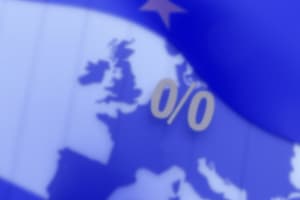Podcast
Questions and Answers
Which of the following is an example of an automatic stabilizer in fiscal policy?
Which of the following is an example of an automatic stabilizer in fiscal policy?
- Reducing income taxes
- Increasing VAT
- Unemployment benefits (correct)
- Constructing a new road
What is the purpose of public administrations intervening to increase competition?
What is the purpose of public administrations intervening to increase competition?
- To reduce tax revenue
- To increase public expenditure
- To create market power
- To avoid dominant market positions (correct)
What is the difference between automatic stabilizers and discretionary fiscal policy?
What is the difference between automatic stabilizers and discretionary fiscal policy?
- Discretionary fiscal policy requires a decision while automatic stabilizers do not
- Automatic stabilizers are always active while discretionary fiscal policy is not (correct)
- Discretionary fiscal policy is always active while automatic stabilizers are not
- Automatic stabilizers require a decision while discretionary fiscal policy does not
What percentage of the EU budget will be spent on fighting climate change?
What percentage of the EU budget will be spent on fighting climate change?
What are the three main sources of funding for the EU budget?
What are the three main sources of funding for the EU budget?
What is the first new own resource introduced to complement Member States' contributions to the EU budget?
What is the first new own resource introduced to complement Member States' contributions to the EU budget?
What is the purpose of the Recovery and Resilience Facility (RRF) programme?
What is the purpose of the Recovery and Resilience Facility (RRF) programme?
Which of the following criteria were used to divide the grant component of the RRF among EU countries?
Which of the following criteria were used to divide the grant component of the RRF among EU countries?
How is the NextGenerationEU instrument being funded?
How is the NextGenerationEU instrument being funded?
What is the main goal of the Stability and Growth Pact (SGP)?
What is the main goal of the Stability and Growth Pact (SGP)?
What is the purpose of the Excessive Deficit Procedure (EDP)?
What is the purpose of the Excessive Deficit Procedure (EDP)?
What is the consequence of a country not following the recommendations of the Corrective Arm of the SGP?
What is the consequence of a country not following the recommendations of the Corrective Arm of the SGP?
What is the Multiannual Financial Framework (MFF)?
What is the Multiannual Financial Framework (MFF)?
What was the EU's government deficit-to-GDP ratio in 2022?
What was the EU's government deficit-to-GDP ratio in 2022?
What was the general government debt relative to GDP in the EU in 2022?
What was the general government debt relative to GDP in the EU in 2022?
What are the four spillovers identified by the founders of the euro in terms of fiscal policy externalities?
What are the four spillovers identified by the founders of the euro in terms of fiscal policy externalities?
What are the problems of fiscal policy?
What are the problems of fiscal policy?
What is the size of the general government sector in the EU and what does it include?
What is the size of the general government sector in the EU and what does it include?
What is the impact of the COVID-19 crisis on the general government deficit in the EU?
What is the impact of the COVID-19 crisis on the general government deficit in the EU?
What are some of the reasons that may justify the application of authorisation schemes and other restrictions according to a case law of the European Court of Justice?
What are some of the reasons that may justify the application of authorisation schemes and other restrictions according to a case law of the European Court of Justice?
What is the consensus regarding the level of services that states should provide according to the text?
What is the consensus regarding the level of services that states should provide according to the text?
Which of the following is NOT a way in which public administrations intervene in economic activities?
Which of the following is NOT a way in which public administrations intervene in economic activities?
What is the difference between automatic stabilizers and discretionary fiscal policy?
What is the difference between automatic stabilizers and discretionary fiscal policy?
What is the main reason for public administrations to intervene in economic activities according to the text?
What is the main reason for public administrations to intervene in economic activities according to the text?
What was the general government deficit-to-GDP ratio in the euro area in 2021?
What was the general government deficit-to-GDP ratio in the euro area in 2021?
What is the main problem with implementing fiscal policy?
What is the main problem with implementing fiscal policy?
What is the current general government debt relative to GDP in the EU?
What is the current general government debt relative to GDP in the EU?
What are the two arguments for retaining sovereignty in fiscal policy coordination?
What are the two arguments for retaining sovereignty in fiscal policy coordination?
What is the purpose of the European Stability Mechanism (ESM)?
What is the purpose of the European Stability Mechanism (ESM)?
What is the sanction imposed by the Council on a delinquent country that breaches the deficit limit?
What is the sanction imposed by the Council on a delinquent country that breaches the deficit limit?
What is the Multiannual Financial Framework (MFF)?
What is the Multiannual Financial Framework (MFF)?
What is the consequence of further non-compliance by a delinquent country with excessive deficits?
What is the consequence of further non-compliance by a delinquent country with excessive deficits?
What is the percentage of the EU budget allocated to administration?
What is the percentage of the EU budget allocated to administration?
What is the purpose of the Recovery and Resilience Facility (RRF)?
What is the purpose of the Recovery and Resilience Facility (RRF)?
How is the NextGenerationEU instrument being funded?
How is the NextGenerationEU instrument being funded?
What are the criteria used to divide the grant component of the RRF among EU countries?
What are the criteria used to divide the grant component of the RRF among EU countries?
What percentage of the NextGenerationEU will be invested in the digital transformation and what is the main goal of this investment?
What percentage of the NextGenerationEU will be invested in the digital transformation and what is the main goal of this investment?
What is the biggest source of funding for the EU budget and how is it determined?
What is the biggest source of funding for the EU budget and how is it determined?
What is the first new own resource introduced to complement Member States' contributions to the EU budget and when did it become effective?
What is the first new own resource introduced to complement Member States' contributions to the EU budget and when did it become effective?
What is the size of the general government sector in the EU and what does it include?
What is the size of the general government sector in the EU and what does it include?
What is the difference between general government expenditures and revenues in the EU and what is the resulting deficit?
What is the difference between general government expenditures and revenues in the EU and what is the resulting deficit?
What is the purpose of the liberalization process in the EU since the 80s and what are the 'reform packages' that drive it?
What is the purpose of the liberalization process in the EU since the 80s and what are the 'reform packages' that drive it?
What are some of the reasons that may justify the application of authorisation schemes and other restrictions according to a case law of the European Court of Justice?
What are some of the reasons that may justify the application of authorisation schemes and other restrictions according to a case law of the European Court of Justice?
Flashcards
Automatic Stabilizers
Automatic Stabilizers
Economic policies that automatically adjust in response to economic changes, such as unemployment benefits.
Discretionary Fiscal Policy
Discretionary Fiscal Policy
Deliberate changes in government spending or taxes to influence the economy.
EU Budget Climate Spending
EU Budget Climate Spending
30% of the EU budget is dedicated to combating climate change.
EU Budget Funding Sources
EU Budget Funding Sources
Signup and view all the flashcards
Carbon Border Adjustment Mechanism (CBAM)
Carbon Border Adjustment Mechanism (CBAM)
Signup and view all the flashcards
Recovery and Resilience Facility (RRF)
Recovery and Resilience Facility (RRF)
Signup and view all the flashcards
RRF Grant Allocation Criteria
RRF Grant Allocation Criteria
Signup and view all the flashcards
NextGenerationEU
NextGenerationEU
Signup and view all the flashcards
Stability and Growth Pact (SGP)
Stability and Growth Pact (SGP)
Signup and view all the flashcards
Excessive Deficit Procedure (EDP)
Excessive Deficit Procedure (EDP)
Signup and view all the flashcards
SGP Sanctions
SGP Sanctions
Signup and view all the flashcards
Multiannual Financial Framework (MFF)
Multiannual Financial Framework (MFF)
Signup and view all the flashcards
EU Government Deficit-to-GDP Ratio
EU Government Deficit-to-GDP Ratio
Signup and view all the flashcards
EU Government Debt-to-GDP Ratio
EU Government Debt-to-GDP Ratio
Signup and view all the flashcards
Fiscal Policy Spillovers
Fiscal Policy Spillovers
Signup and view all the flashcards
Fiscal Policy Problems
Fiscal Policy Problems
Signup and view all the flashcards
General Government Sector Size
General Government Sector Size
Signup and view all the flashcards
COVID-19 Impact on Fiscal Policy
COVID-19 Impact on Fiscal Policy
Signup and view all the flashcards
Public Administration Intervention
Public Administration Intervention
Signup and view all the flashcards
European Stability Mechanism (ESM)
European Stability Mechanism (ESM)
Signup and view all the flashcards
Sanctions for Deficit Breaches
Sanctions for Deficit Breaches
Signup and view all the flashcards
Non-compliance Consequences
Non-compliance Consequences
Signup and view all the flashcards
EU Budget Administration Allocation
EU Budget Administration Allocation
Signup and view all the flashcards
EU Liberalization Process
EU Liberalization Process
Signup and view all the flashcards
Study Notes
Fiscal Policy and EU Budget
- An example of an automatic stabilizer in fiscal policy is unemployment benefits, which increase during recessions and decrease during economic booms.
- Public administrations intervene to increase competition to promote economic efficiency and innovation.
- The main difference between automatic stabilizers and discretionary fiscal policy is that automatic stabilizers respond automatically to changes in the economy, whereas discretionary fiscal policy requires a conscious decision by policymakers.
- 30% of the EU budget will be spent on fighting climate change.
- The three main sources of funding for the EU budget are Member States' contributions, customs duties, and VAT-based resources.
- The first new own resource introduced to complement Member States' contributions to the EU budget is the Carbon Border Adjustment Mechanism (CBAM), which became effective in 2023.
- The purpose of the Recovery and Resilience Facility (RRF) programme is to support EU countries in their recovery from the COVID-19 crisis and promote economic resilience.
- The grant component of the RRF is divided among EU countries based on their GDP, population, and unemployment rate.
- The NextGenerationEU instrument is being funded through a combination of borrowing and grants from the EU budget.
Stability and Growth Pact (SGP)
- The main goal of the SGP is to ensure that EU countries maintain sound public finances and coordinate their fiscal policies.
- The Excessive Deficit Procedure (EDP) is a mechanism to correct excessive government deficits in EU countries.
- The consequence of a country not following the recommendations of the Corrective Arm of the SGP is the imposition of sanctions and fines.
- The Multiannual Financial Framework (MFF) is a framework that sets the EU's budget for a period of several years.
EU Economic Indicators
- The EU's government deficit-to-GDP ratio in 2022 was 3.4%.
- The general government debt relative to GDP in the EU in 2022 was 88.5%.
- The four spillovers identified by the founders of the euro in terms of fiscal policy externalities are the risk of default, the risk of inflation, the risk of unfair competition, and the risk of macroeconomic instability.
- The problems of fiscal policy include time inconsistency, free riding, and the risk of macroeconomic instability.
- The size of the general government sector in the EU includes all public entities, including central government, local government, and social security funds, and accounts for around 45% of the EU's GDP.
- The COVID-19 crisis led to a significant increase in the general government deficit in the EU.
Public Administration and Fiscal Policy
- Public administrations intervene in economic activities to correct market failures, promote public goods, and redistribute income.
- The main reason for public administrations to intervene in economic activities is to correct market failures.
- The European Stability Mechanism (ESM) is a mechanism to provide financial assistance to EU countries facing financial difficulties.
- The sanction imposed by the Council on a delinquent country that breaches the deficit limit is a fine of up to 0.2% of its GDP.
- The consequence of further non-compliance by a delinquent country with excessive deficits is the imposition of additional sanctions and fines.
- Around 6% of the EU budget is allocated to administration.
- The purpose of the liberalization process in the EU since the 80s is to promote economic efficiency and competition, and the 'reform packages' that drive it include deregulation, privatization, and trade liberalization.
Studying That Suits You
Use AI to generate personalized quizzes and flashcards to suit your learning preferences.



